Papers by G. Hassan Khajavy
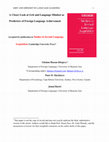
Studies in Second Language Acquisition, 2020
Learning a second/foreign language (L2) is a long process and L2 learners certainly will encounte... more Learning a second/foreign language (L2) is a long process and L2 learners certainly will encounter setbacks and discouragements during this process. However, their reactions to these failures might be different based on their perceptions of L2 learning ability and their subsequent effort put into L2 learning. Based on this, the present study aimed at exploring two under-researched constructs within the field of applied linguistics, namely grit (“perseverance and passion for long-term goals”, Duckworth, Peterson, Matthews, & Kelly, 2007, p. 1087) and language mindset (individuals’ perceptions of their language learning ability, Mercer & Ryan, 2009). We had five main aims: 1) to examine the factor structure of grit, 2) to examine the factor structure of language mindset, 3) to examine whether there are gender differences in grit or language mindset, 4) to examine the relationships between language mindset and grittiness, and 5) to examine the roles of grit and language mindset as predictors of L2 achievement. To address these aims, a total number of 1,178 university students who were taking general English courses took part in our study and completed the questionnaires. Results of confirmatory factor analysis indicated that the two-factor structure for both grit and language mindset fitted the data better than the single-factor structure. We also tested several structural equation models and found that a growth language mindset weakly, but positively predicted one component of grit (perseverance of effort), but not the other (consistency of interest). A fixed language mindset did not predict perseverance of effort, but did negatively predict consistency of interest. Finally, only growth language mindset was a weak, positive predictor of L2 achievement. At the end, theoretical and pedagogical implications regarding the role of grit and language mindset in L2 learning are presented.
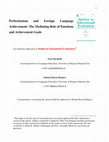
Studies in Educational Evaluation, 2020
The purpose of the present study was to examine the role of perfectionism in the second/foreign l... more The purpose of the present study was to examine the role of perfectionism in the second/foreign language (L2) learning context. To this end, we investigated the possible links between perfectionism, emotions, achievement goals, and L2 achievement. A total number of 2008 secondary school students completed the relevant questionnaires. First, confirmatory factor analysis was performed to assure the construct validity of the questionnaires. Then, separate structural equation models were conducted to examine the relations among variables. Results indicated that adaptive perfectionism was directly related to positive emotions, while the opposite pattern was found for maladaptive perfectionism. Moreover, only adaptive perfectionism was related to mastery goals, and both adaptive and maladaptive perfectionisms were related to performance-approach goals and performance-avoidance goals. Maladaptive perfectionism dimensions were negatively related to L2 achievement, while one dimension of adaptive perfectionism had positive relation and another one had negative relation with L2 achievement. Finally, mediation analysis was performed and results showed that only negative emotions and only mastery goals could mediate the relation between perfectionism dimensions and L2 achievement.

Journal of Psycholinguistic Research, 2018
Why do some students frequently ask questions and actively seek out answers in the classroom, whi... more Why do some students frequently ask questions and actively seek out answers in the classroom, while others avoid this? Many language teachers might have commonly asked themselves this question. The present study is an empirical investigation of the concept of curiosity in the field of second language acquisition (SLA). Using a mixed-methods design, we aim to conceptualize language learning curiosity (LLC) within the framework of interest/deprivation (I/D) model of curiosity (Litman & Jimerson, 2004) and see how it may be recognizably distinct from L2 psychological constructs, as well as how it connects with related constructs such as willingness to communicate (WTC), enjoyment, and anxiety. To measure LLC and depict its underlying dimensions, a new curiosity scale was developed and validated in this study. Overall, our results suggest that LLC can be conceived as an affective-cognitive variable reflecting an inquiry-driven interest and desire to learn and use a foreign language.

Iranian Journal of Language Teaching Research, 2018
Drawing upon appraisal-theoretical framework (Frenzel, 2014), this study aimed at examining the a... more Drawing upon appraisal-theoretical framework (Frenzel, 2014), this study aimed at examining the antecedents of pleasant and unpleasant emotions experienced by English as a foreign language (EFL) teachers in Iran. Results of semi-structured interviews with eleven EFL teachers teaching in private language institutes showed that positive interaction with students, motivated students, and students' progress were the most frequently mentioned antecedents of enjoyment. For pride, positive feedback from students and students' progress were identified as the key antecedents. For anxiety and shame, inability to answer students' questions was the key antecedent, while shame was additionally triggered by responsibility for student failure, and anxiety was additionally triggered by class observation by supervisors, and lack of preparation. For anger, disciplinary issues, lack of student commitment to tasks and homework, and having to explain a topic to students several times when they do not understand were identified as the key antecedents. Demotivated and uncollaborative students were identified as antecedents of boredom. In the end, the findings were discussed and pedagogical and research implications were suggested.
This study examined whether teachers and students agree in their perceptions of the mastery goal ... more This study examined whether teachers and students agree in their perceptions of the mastery goal structures dimensions task, autonomy, recognition/evaluation, and grouping. Additionally, potential predictors, namely students’ achievement and teachers’ basic psychological need satisfaction at work, were investigated. Using a sample of 1,099 secondary school students and their 57 teachers, results from multilevel structural equation models revealed moderate agreement for grouping and no agreement for the other dimensions. Higher levels of achievement narrowed the gap between teachers’ and students’ perceptions of autonomy and recognition/evaluation. No effects of need satisfaction were found for any of the mastery goal structures dimensions.
The present study aimed at testing a model of intercultural willingness to communicate based on e... more The present study aimed at testing a model of intercultural willingness to communicate based on ethnocentrism, ambiguity tolerance and sensation seeking between English and non-English major university students in Iran. A significant difference was found between the two groups on ethnocentrism and the results showed that the model fit the data adequately. Ethnocentrism was the strongest predictor of intercultural willingness to communicate for both groups. Sensation seeking was a significant predictor of intercultural willingness to communicate only for the non-English major university students. Moreover, sensation seeking and ambiguity tolerance were significant predictors of ethnocentrism.
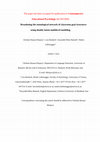
Studies investigating the effects of classroom goal structures have focused on relations with ach... more Studies investigating the effects of classroom goal structures have focused on relations with achievement goals. Furthermore, most of these studies were conducted in Western countries, leaving it open to question whether the derived results apply to other cultural contexts as well. Additionally, the recent methodological development of doubly latent multilevel modeling has not yet been employed in classroom goal structures research. Therefore, this study used doubly latent multilevel modeling to examine the relations between mastery classroom goal structures and a set of motivational constructs (self-efficacy, self-concept, interest, personal best goals, achievement goals) in Iran. Relations between motivational constructs and academic achievement were also investigated. A sample of 1200 Iranian secondary school students filled out a questionnaire during regular class hours. Results indicated positive relations between mastery classroom goal structures and all motivational constructs at the classroom level. At the individual student level, positive relations between all motivational constructs and achievement were shown.

Studies in Second Language Acquisition, 2017
The purpose of the present study was to examine the relations between emotions, classroom environ... more The purpose of the present study was to examine the relations between emotions, classroom environment, and willingness to communicate using the advanced quantitative methodological procedure of doubly latent multilevel analysis. To this end, 1528 secondary school students from 65 different classrooms in Iran participated in the study. Results of the doubly latent multilevel analysis showed that a positive classroom environment is related to fostering willingness to communicate and enjoyment, while it reduces anxiety among students. Moreover, enjoyment was found as an important factor in increasing willingness to communicate at both student and classroom level, while anxiety reduced willingness to communicate only at the student level. Findings further indicated that classrooms which used the communicative language teaching programs were more willing to communicate than traditional classrooms in the Iranian context.
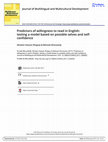
The aim of the present study is twofold. First, it tests a model of willingness to read (WTR) bas... more The aim of the present study is twofold. First, it tests a model of willingness to read (WTR) based on L2 motivation and communication confidence (communication anxiety and perceived communicative competence). Second, it applies the recent theory of L2 motivation proposed by Dörnyei (2005; 2009), L2 motivational self system (ideal L2 self, ought-to L2 self, and L2 learning experience), in willingness to communicate and WTR construct. For this purpose, one-hundred eighty Iranian university students who were taking general English courses completed the survey questionnaire. Structural equation modeling was utilized to analyze the proposed model of WTR. Results of the analysis indicated that L2 learning experience, ideal L2 self, and communication confidence positively and significantly predicted WTR, and L2 learning experience was the strongest predictor of WTR. Moreover, among the three measures of L2 motivational self system, ideal L2 self was the strongest positive predictor of communication confidence, and ought-to L2 self contributed to communication confidence negatively. The results suggest that L2 motivational self system framework can adequately account for willingness to communicate. Also, in contrast to previous studies, it has a higher explanatory power than communication confidence in predicting L2 WTR.
Routledge
The present study aimed at testing a model of intercultural willingness to communicate based on e... more The present study aimed at testing a model of intercultural willingness to communicate based on ethnocentrism, ambiguity tolerance, and sensation seeking between English and non-English major university students in Iran. A significant difference was found between the two groups on ethnocentrism and the results showed that the model fit the data adequately. Ethnocentrism was the strongest predictor of intercultural willingness to communicate for both groups. Sensation seeking was a significant predictor of intercultural willingness to communicate only for the non-English major university students. Moreover, sensation seeking and ambiguity tolerance were significant predictors of ethnocentrism.

TESOL Quarterly (John Wiley Publications)
This study examined willingness to communicate (WTC) in English among Iranian EFL learners in the... more This study examined willingness to communicate (WTC) in English among Iranian EFL learners in the classroom context. For this purpose, an L2WTC model based on WTC theory (MacIntyre, Clément, Dörnyei, & Noels, 1998) and empirical studies was proposed and tested using Structural Equation Modeling (SEM). This model examined the inter-relationships among WTC in English, communication confidence, motivation, classroom environment, attitudes toward learning English, and English language achievement. A total number of 243 English-major university students in Iran completed a questionnaire. The proposed SEM model adequately fit the data. Results of the SEM indicated that classroom environment was the strongest direct predictor of L2WTC, communication confidence directly affected WTC, motivation indirectly affected WTC through communication confidence, English language proficiency indirectly affected WTC through communication confidence, and the classroom environment directly affected attitudes, motivation, and communication confidence.
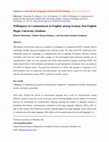
Journal of Language and Social Psychology (SAGE), 2012
The purpose of the present study is to examine willingness to communicate in the second language ... more The purpose of the present study is to examine willingness to communicate in the second language (L2WTC) construct and its underlying variables among non–English major students in Iran. The study used WTC and socioeducational models for examining L2 communication and L2 learning. Descriptive statistics, Pearson correlation, and t test were used with a sample of 158 non–English major university students. An L2 communication model was also proposed and tested using structural equation modeling. The results showed that L2 self-confidence and attitudes toward international community were two predictors of L2WTC in Iranian context. The paths from motivation to L2WTC and openness to experience to L2 self confidence were not significant and thus were deleted. The model shows a good fit to the data, which indicates the potential for using the L2WTC construct for English as a foreign language context.
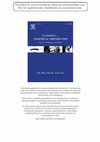
Learning and Individual Differences (ELSEVIER), 2013
This study examined the role of metacognition and intelligence in foreign language achievement on... more This study examined the role of metacognition and intelligence in foreign language achievement on a sample of 143 Iranian English as a Foreign Language (EFL) learners. Participants completed Raven's Advanced Progressive Matrices as a measure of intelligence, and Metacognitive Awareness Inventory as a measure of metacognition. Learners' scores at the end of the semester were aggregated as a measure of foreign language achievement. The findings revealed that intelligence accounts for 12.2% of the variance in foreign language achievement, and metacognition accounts for 17.6% of the variance. Although each of them had a unique impact on foreign language achievement, metacognition outweighs intelligence as a predictor of foreign language achievement. Finally, the pedagogical implications were discussed in light of foreign language achievement.
The purpose of the present study was to explore English as a Foreign Language (EFL) teacher's mot... more The purpose of the present study was to explore English as a Foreign Language (EFL) teacher's motivations for teaching and testing a model of burnout based on motivations and emotions using structural equation modeling (SEM). For this purpose, a total number of 326 Iranian EFL teachers in different language institutes completed the related scales. Results of the study showed that altruistic and intrinsic factors are the main motivations of EFL teachers. Results of SEM indicated that both motivations and emotions predicted different dimensions of burnout. However, emotions had a stronger effect on burnout dimensions than motivational factors. Finally, the pedagogical implications were discussed based on the results of the study.
Journal of cross-cultural gerontology (Springer), 2012
Guided by the communicative predicative model of aging, American and Iranian young adults’ percep... more Guided by the communicative predicative model of aging, American and Iranian young adults’ perceptions of communication with their peers, middle-aged and elderly adults were examined; subjective boundaries for these age categories were also explored. As age of target increased, so did attributions of benevolence, norms of politeness and deference, and communicative respect and avoidance; conversely, attributions of personal vitality and communication satisfaction decreased linearly. Path analysis was also adopted to examine the simultaneous relationships between the variables under study, and ultimately with cultural caveats largely supported, a hypothesized model was derived. The data were discussed in terms of their yielding refinements and elaborations to the communicative predicament and enhancement models of aging.
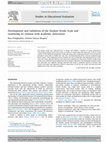
Studies In Educational Evaluation (ELSEVIER), 2014
The present study was conducted first, to design and validate a measure of stroke grounded in Tra... more The present study was conducted first, to design and validate a measure of stroke grounded in Transactional Analysis theory and second, to examine its relationship with motivation. To do so, a total number of 348 individuals completed a stroke scale along with a motivation measure. Several statistical procedures were taken to validate the scale. First, uni-dimensionality of the scale was examined using Rasch analysis. Then, exploratory factor analysis was used to determine the underlying factors of the scale. The results indicated that the scale can be best explained by a four-factor solution. Finally, these results were confirmed using confirmatory factor analysis. Moreover, the relationship between stroke and motivation was explored. Findings indicated that stroke is positively related to extrinsic and intrinsic motivation and negatively related to amotivation. In the end, the results were discussed and implications of the scale were presented.
Communication Reports (Routledge, Taylor and Francis), 2013
This article examines Mongolian and American young adults' perceptions of prior experiences of in... more This article examines Mongolian and American young adults' perceptions of prior experiences of intergenerational communication. Irrespective of culture, as age of targets increased from young adulthood to older adulthood, so did attributions of benevolence, norms of politeness and deference, and communicative respect and avoidance; conversely, stereotypes of personal vitality decreased linearly. Mongolian youth expressed more stereotypic personal vitality and less normative politeness, yet more normative deference and less communicative avoidance toward older adults. In addition, differences were revealed across the nations with regard to when young adulthood and middle age begins and ends, and when elderliness begins.
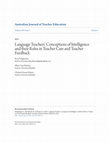
The purpose of this study was to find the relationships among teachers’ conceptions of intelligen... more The purpose of this study was to find the relationships among teachers’ conceptions of intelligence, teacher care, and teacher feedback in the realm of English Language Teaching (ELT). To this aim, three scales were developed to measure the aforementioned constructs. The participants consisted of 81 English as a Foreign Language (EFL) teachers and their 426 students who were learning English in private language institutes. The scales were validated by Confirmatory Factor Analysis (CFA) and the correlations among their subscales were investigated. The findings suggested that modularity, increasability, and applied ELT are associated with the nature and amount of teacher feedback and care as perceived by the students. Moreover, the results revealed that teachers’ conceptions of intelligence significantly affect how they evaluate their students (p < .05). In the end, implications were provided in the context of teaching
The purpose of the present study is to examine the Iranian EFL learners' level of willingness to ... more The purpose of the present study is to examine the Iranian EFL learners' level of willingness to communicate in English, and the relationships between willingness to communicate, communication confidence, and classroom environment. For this purpose, 243 Iranian EFL learners participated in this study. Results of the descriptive statistics indicated that participants were moderately willing to communicate in English inside the language classroom, felt low levels of anxiety, and perceived themselves moderately confident to communicate in English in the classroom. Correlational analyses also indicated that willingness to communicate is positively correlated with classroom environment and perceived communicative competence, and negatively correlated with communication anxiety.
This study aims to explore to what degree the in-service Iranian English teachers’ sense of self-... more This study aims to explore to what degree the in-service Iranian English teachers’ sense of self-efficacy and metacognitive
awareness predict their academic performance A total number of 107 Iranian EFL teacher trainees at Farhangian University were
asked to complete Teachers’ Sense of Self-Efficacy Scale (TSES) (Woolfolk & Hoy,1990) and Metacognitive Awareness
Inventory for Teachers (MAIT) (Balcikanli, 2011). Results of the Path Analysis indicated that both metacognition and selfefficacy
affect the academic performance. However, metacognition had a stronger effect. Also, results of t-test showed that there
is no difference between males and females self-efficacy and metacognition.










Uploads
Papers by G. Hassan Khajavy
awareness predict their academic performance A total number of 107 Iranian EFL teacher trainees at Farhangian University were
asked to complete Teachers’ Sense of Self-Efficacy Scale (TSES) (Woolfolk & Hoy,1990) and Metacognitive Awareness
Inventory for Teachers (MAIT) (Balcikanli, 2011). Results of the Path Analysis indicated that both metacognition and selfefficacy
affect the academic performance. However, metacognition had a stronger effect. Also, results of t-test showed that there
is no difference between males and females self-efficacy and metacognition.
awareness predict their academic performance A total number of 107 Iranian EFL teacher trainees at Farhangian University were
asked to complete Teachers’ Sense of Self-Efficacy Scale (TSES) (Woolfolk & Hoy,1990) and Metacognitive Awareness
Inventory for Teachers (MAIT) (Balcikanli, 2011). Results of the Path Analysis indicated that both metacognition and selfefficacy
affect the academic performance. However, metacognition had a stronger effect. Also, results of t-test showed that there
is no difference between males and females self-efficacy and metacognition.